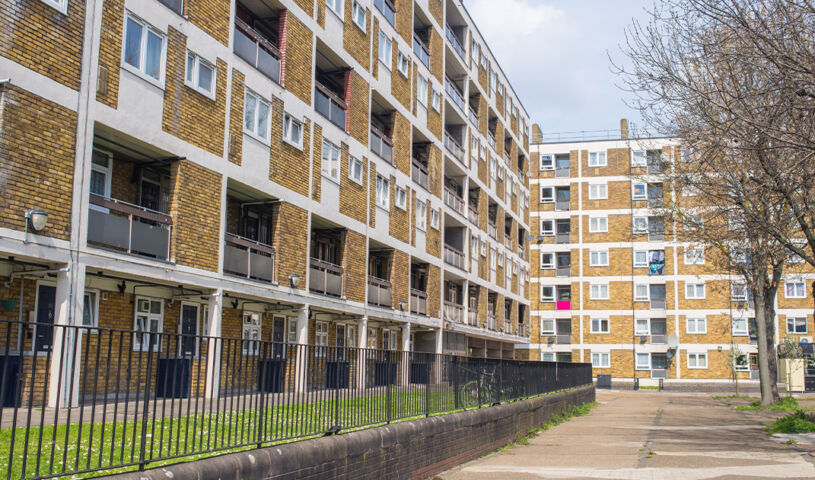Social housing waitlists growing across Canada’s big cities
 In 2022, it was estimated 1.4 million households did not have access to quality housing. But a 2023 report estimates Canada is short 4.4 million homes. Photo: Adobe Images
In 2022, it was estimated 1.4 million households did not have access to quality housing. But a 2023 report estimates Canada is short 4.4 million homes. Photo: Adobe Images
The number of people on waitlists for social housing in Canada’s cities is rising sharply. In 2022, the Canada Mortgage and Housing Corporation (CMHC) said 1.4 million households did not have access to quality housing.
“We know that far too many people in Canada are struggling to find shelter and affordable housing that meets their needs,” said then CMHC President and CEO Romy Bowers. “We need to come together, now more than ever, to build shelters for the homeless, support families in housing need, and deliver more homes for Canadians.”
However, a November 2023 report from the Office of the Federal Housing Advocate (OFHA) estimated that Canada is short of about 4.4 million affordable homes. That report, authored by housing policy expert Carolyn Whitzman, stated the CMHC report “does not prioritize who is most in need of adequate housing, and it does not provide a sense of who needs what housing where and at what cost.”
The OFHA report stated, “There exists a current shortfall of three million homes affordable to very low- and low-income households and 1.4 million homes affordable to moderate- and median-income households.”
CMHC projects that Canada needs to build around 3.5 additional homes by 2030. However, the OFHA report said the country will need closer to 9.6 million new homes by 2031.
Vancouver Housing Waitlists Skyrocket
Metro Vancouver released its housing data book for 2023, showing a 27 per cent growth in the number of people waiting for social housing. In September 2023, there were 18,865 households on the BC Housing’s social housing waitlist in the Metro Vancouver region. That represented an increase of 4,008 households from June 2022.
“Demand of social housing has grown much faster than the rate of population growth, serving as one indicator of the unmet housing need in the region,” the data book stated.
“Of course, the waiting list for social housing is getting higher, and I promise you that the numbers will get even higher soon,” said Wendy Pedersen, founder and executive director of the Downtown Eastside SRO Collaborative. Pedersen added that getting social housing was becoming so difficult that it is “literally like winning the lottery.”
Most of that increase was driven by family and senior households. BC Housing’s data showed that around 7,013 senior households and 6,757, family households were on the waitlist. Around 2,330 people with disabilities were also waiting for social housing while just under 2,100 single person households were on the waitlist.
“Imagine yourself 85 years of age and you have to find a place to rent,” said Isobel Mackenzie, a seniors advocate at the office. “You last tried to rent a place 40 years ago and now, suddenly, you’re dealing with 300 people lining up to rent an apartment.”
Core Need Housing Dilemma
Langley, Delta, and Richmond where the three cities with the highest waitlist growth between 2018 and 2023. Langley saw an increase of 112 per cent. In Delta, the number was 107 per cent, while Richmond saw a rise of just under 82 per cent.
“In the five years between 2018 and 2023, the number of households on the regional waitlist increased by 53.5 per cent,” the data book reported. “In comparison, the total number of households in the region increased by 8.6 per cent between 2016 and 2021.”
Data also highlighted a rise in the number of households in “core housing need.” A person or family is considered to be in core need if their home falls below set standards for adequacy, suitability or affordability and need to spend at least 30 per cent of their total before-tax income.
According to the 2021 census, almost half the households in core need in Metro Vancouver were single-person households. In addition, around 41 per cent of all single-parent renters in the region were in core housing need.
The number of people who are homeless in Metro Vancouver has also been on the rise. “Between 2005 and 2023, the region saw a 122 per cent increase in the number of people experiencing homelessness,” the data book stated. “Homelessness in 2023 increased by 33 per cent since the last count in 2020.
Toronto Commits to 285,000 Homes
In 2023, there were 85,097 total active applicants waiting for subsidized housing in Toronto, according to data from the city. That represented an increase of 815 from 2022. A 2021 assessment by the City of Toronto also found there were more than 7,000 people homeless in the city, though other measures have indicated that the true figure could be over 18,000.
In December, the federal government allocated $471 million to fund an additional 11,780 homes in Toronto on top of what has already been projected over the next three years. The funding with be provided through the Housing Accelerator Fund.
“Toronto is ready to build. We’ve set a new goal of building 65,000 rent-controlled homes, and we’re committed to the provincial target of 285,000 homes by 2031,” said Mayor Olivia Chow. “Housing Accelerator Fund investments are essential to addressing the housing crisis and meeting these targets. Everyone deserves an affordable roof over their heads, and today’s announcement helps make that a reality.”
Housing a Worldwide Issue
Unaffordable housing is becoming a growing problem all around the world. In the United States, a recent report found that housing is now unaffordable for half of all renters. The report from Harvard University’s Joint Center for Housing Studies stated that unaffordability in the U.S. has hit an all-time high.
“At last measure in 2022, a record-high 22.4 million renter households spent more than 30 percent of their income on rent and utilities,” the report said. “Among cost-burdened households, 12.1 million had housing costs that consumed more than half of their income, an all-time high for severe burdens.”
Reports of growing unaffordability come in the wake of record homelessness across the country. The U.S. department of Housing and Urban Development released a report in December which found more than 650,000 people were homeless – up 12 per cent from the year before. MW
✯ Municipal World Executive and Essentials Plus Members: You might also be interested in Thomas Sanderson’s article: Managing gentle density and defining what is “minor”.
Ibrahim Daair is Staff Writer at Municipal World.
Related resource materials:



